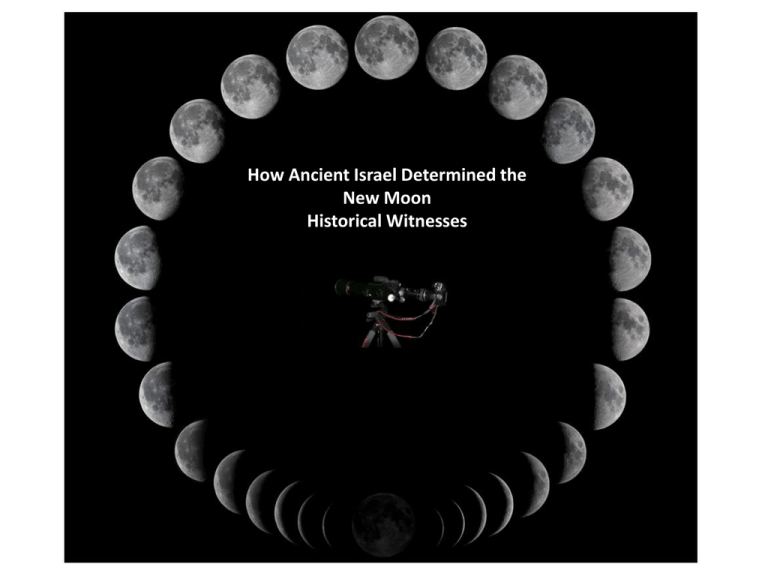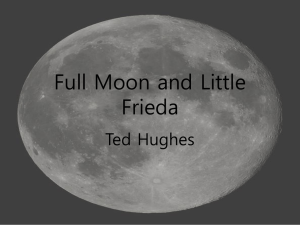The New Moon, in the Light or in the Darkness?
advertisement

How Ancient Israel Determined the New Moon Historical Witnesses In the Library of Alexandria Philo’s writings could be found: When Philo says that “nothing in the whole heaven [is] destitute of light” he is referring to the moon when it first becomes visible to the naked eye. Philo refers to the conjunction elsewhere and says that it is “dark.” Notice that he synchronizes the new moon with both the time of the month’s beginning, and the numbering of the days. It is a scientific fact that at the conjunction the moon is “destitute of light” with respect to the ability of any human to perceive it. Philo would be misleading here if he did not mean the first visible new moon, for before it appears there is something “destitute of light,” namely the moon. Scenes from the Movie Agora Philo of Alexandria, a great Jewish philosopher, and prolific writer and commentator on Torah: De specialibus legibus 2:140 Following the order which we have adopted, we proceed to speak of the third festival, that of the new moon. First of all, because it is the beginning of the month, and the beginning, whether of number or of time, is honorable. Secondly, because at this time there is nothing in the whole of heaven destitute of light. 2:141 Thirdly, because at that period the more powerful and important body gives a portion of necessary assistance to the less important and weaker body; for, at the time of the new moon, the sun begins to illuminate the moon with a light which is visible to the outward senses, and then she displays her own beauty to the beholders. And this is, as it seems, an evident lesson of kindness and humanity to men, to teach them that they should never grudge to impart their own good things to others, but, imitating the heavenly bodies, should drive envy away and banish it from the soul. Again, speaking of the Sun, Philo says that at the new moon it lights the moon. Philo says “visible to the outward senses.” This is his way of saying the moon is visible to the naked eye. Philo of Alexandria, a great Jewish philosopher, and prolific writer and commentator on Torah: De specialibus legibus 2:140 Following the order which we have adopted, we proceed to speak of the third festival, that of the new moon. First of all, because it is the beginning of the month, and the beginning, whether of number or of time, is honorable. Secondly, because at this time there is nothing in the whole of heaven destitute of light. 2:141 Thirdly, because at that period the more powerful and important body gives a portion of necessary assistance to the less important and weaker body; for, at the time of the new moon, the sun begins to illuminate the moon with a light which is visible to the outward senses, and then she displays her own beauty to the beholders. And this is, as it seems, an evident lesson of kindness and humanity to men, to teach them that they should never grudge to impart their own good things to others, but, imitating the heavenly bodies, should drive envy away and banish it from the soul. Here Philo says the new moon comes after the conjunction, “μετὰ σύνοδον”; this generalization eliminates the day of the conjunction as the new moon day, since the feast could well occur before the conjunction if the feast was on the same day as the conjunction. In theory one could build a perfect calendar composed of 29 and 30 day months based on the conjunction, but this is the second Philo text that we see rules this out. Philo of Alexandria, a great Jewish philosopher, and prolific writer and commentator on Torah: De specialibus legibus 2:41 I. Now there are ten festivals in number, as the law sets them down. The first is that which any one will perhaps be astonished to hear called a festival. This festival is every day. The second festival is the seventh day, which the Hebrews in their native language call the sabbath. The third is that which comes after the conjunction, which happens on the day of the new moon in each month. The fourth is that of the passover which is called the pascha. The fifth is the first fruits of the corn-- the sacred sheaf. The sixth is the feast of unleavened bread, after which that festival is celebrated, which is really the seventh day of seventh days. The eighth is the festival of the sacred moon, or the feast of trumpets. The ninth is the fast. The tenth is the feast of tabernacles, which is the last of all the annual festivals, ending so as to make the perfect number of ten. We must now begin with the first festival. Here Philo says, “in the full light of the moon” (τῆς πλησιφαοῦς σελήνης). This is clearly not a technical phrase for “full moon” as astronomers might mean it in the 100% phase sense. “In the full light of the moon” is a phrase more general indicating the general time of the full moon, such that “in the full light” refers to as much light as reaches earth, and not to the diameter of light on the face of the moon. The “full light of the moon” means the subject or target on earth is fully lighted by the moon. This is different than the phrase “full moon.’ Philo of Alexandria, a great Jewish philosopher, and prolific writer and commentator on Torah: De specialibus legibus 1:189 And on the 15th day, in the full light of the moon, is led forth what is called the tabernacles feast. (τῇ δὲ πεντεκαιδεκάτῃ τῆς πλησιφαοῦς σελήνης ἄγεται ἡ ἐπικαλουμένη σκηνῶν ἑορτή). I had to correct the translation of this text. It is a perfect example of not checking the translators against the original text. The Greek here reads, “αἱ μὲν γὰρ ἀνάγονται καθ᾽ ἑκάστην ἡμέραν, αἱ δὲ ταῖς ἑβδόμαις, αἱ δὲ νουμηνίαις καὶ ἱερομηνίαις, αἱ δὲ νηστείαις, αἱ δὲ τρισὶ καιροῖς ἑορτῶν.” The words which I have translated “the holy time of the month” has been corrected from “full moon.” Philo’s Greek word ἱερομηνίαις does not mean “full moon”; it means “the holy time of the month” (exact wording from Liddell Scott Lexicon). Philo is not saying here that the feast falls on the day of the full moon. Also, note that the Greek text of this passage is displaced in Bible Works 8 to section 1:168. (A poor job of synchronizing the Greek and English text.) Philo of Alexandria, a great Jewish philosopher, and prolific writer and commentator on Torah: De specialibus legibus 1:169 For some of them are offered up every day, and some on the days of the new moon, and at the festivals of the holy time of month; others on days of fasting; and others at three different occasions of festival. Accordingly, it is commanded that every day the priests should offer up two lambs, one at the dawn of day, and the other in the evening; each of them being a sacrifice of thanksgiving; the one for the kindnesses which have been bestowed during the day, and the other for the mercies which have been vouchsafed in the night, which God is incessantly and uninterruptedly pouring upon the race of men. This chart by Dr. Irv Bromberg shows why the full moon cannot fall on a fixed day of the month, but must vary over three days. The blue graph shows the 13.5 hour variation of a full lunar cycle between 29.25 and 29.75 days (or so). The red and black graphs show that the full moon ranges over at least 30 hours between the high 13th day and mid 15th day. Thus it does not matter if the month starts at conjunction, the day after the conjunction, two days after the conjunction, or at the first sighting (whichever consistent method is used). The full moon will always vary the day number it falls on in every calendar. The following graphs show the changing relation between the conjunction and the full moon two weeks later, and what day of the month the full moon will come on. The white moon is the full moon. Add two weeks to the date of the day under it for the date of the full moon, i.e. in the first example Jan 16 + 14 = Jan 30th. 14 Jan 15, 2010 Jan 16, 2010 Jan 17, 2010 1 14 Feb 14, 2010 Feb 15, 2010 1 Feb 16, 2010 13 Mar 16, 2010 Mar 17, 2010 1 13 Apr 14, 2010 Apr 15, 2010 1 Apr 16, 2010 May 15, 2010 1 13 May 14, 2010 May 16, 2010 13 June 11, 2010 June 12, 2010 June 13, 2010 1 13 Jul 12, 2010 Jul 13, 2010 1 14 Aug 10, 2010 Aug 11, 2010 1 13 Sep 8, 2010 Sep 9, 2010 Sep 10, 2010 14 Oct 8, 2010 Oct 9, 2010 1 15 Nov 6, 2010 Nov 7, 2010 1 14 Dec 6, 2010 Dec 7, 2010 15 Jan 4, 2010 Jan 5, 2010 1 1 1 14 Feb 3, 2010 Feb 4, 2010 1 1/15 7/14 6/13 2/16 5/12 4/11 3/17 De opificio mundi 1:101 XXXIV. Among the things then which are perceptible only by intellect, the number seven is proved to be the only thing free from motion and accident; but among things perceptible by the external senses, it displays a great and comprehensive power, contributing to the improvement of all terrestrial things, and affecting even the periodical changes of the moon. And in what manner it does this, we must consider. The number seven when compounded of numbers beginning with the unit, makes eight-and-twenty, a perfect number, and one equalised in its parts. And the number so produced, is calculated to reproduce the revolutions of 4/18 5/19 6/20 7/21 the moon, bringing her back to the point from which she first began to increase in a manner perceptible by the external senses, and to which she returns by waning. For she increases from her first crescent-shaped figure, to that of a half circle in seven days; and in seven more, she becomes a full orb; and then again she turns back, retracing the same path, like a runner of the diaulos, receding from an orb full of light, to a half circle again in seven days, and lastly, in an equal number she diminishes from a half circle to the form of a crescent; and thus the number before mentioned is completed. 3/10 2/9 1/8 7 6 1/22 2/23 5 3/24 4 4/25 1 5/26 6/27 2 3 1/15 7/14 6/13 2/16 5/12 4/11 3/17 4/18 3/10 We don’t really know if Philo was scientifically unaware that the number of visibility days could be less than 28. We must remember that he is not just a Jewish Theologian. He is also a Greek Philosopher, and Greek philosophy had a love affair with symmetry and its beauties. Ascribing mathematical symmetry to natural phenomenon often took priority over the asymmetry of scientific reality. 5/19 2/9 1/8 6/20 7 7/21 6 1/22 2/23 5 3/24 4 4/25 1 5/26 6/27 2 3 1/15 7/14 6/13 2/16 5/12 4/11 3/17 4/18 3/10 Note that this month shows only 27 days in which the moon is visible. This is often the case, where the first visibility of the new moon is on the 1st day, and the last visibility of the waning moon is at daybreak on the 27th day. 5/19 2/9 The last visibility can be calculated with the same rules as first visibility. I have run a number of test cases just to make sure that some months only have 27 days on which the moon can be seen. 6/20 1/8 The astronomer who made this collage also recognized the fact that the moon often could be seen for only 27 days. 7/21 7 6 1/22 2/23 5 3/24 4 4/25 1 5/26 6/27 2 3 Here is a model of Johannes Kepler’s Platonic solid model of the Solar system from Mysterium Cosmographicum (1600). This is a perfect example of the ideal philosophy of Greek thought. Kepler was looking for creation to fit into perfectly symmetrical mathematical shapes. The notion that symmetry is the only beauty is a Greek idea. Asymmetrical variety is also beautiful. In fact the two sides the human body have asymmetry as well as symmetry. The number of days in a month and the number of months in a year display variations. The notion that the timing of the full moon should vary more than one’s notion of proper symmetry is a philosophical assumption. It is not an argument for the way things are or should be. Thomas Aquinas pointed out that the Greek idea of perfection did not allow change, because the only change from perfection could be to imperfection. Thus if two sides of a thing were perfect, then they had to be exactly the same, showing perfect symmetry. Aquinas applied this philosophy to divine immutability. The Almighty was not allowed to change. However, the Creator’s creation bears witness to a different kind of beauty, which is one that balances asymmetry with symmetry. Variety is balanced with uniformity and sameness. The Creator knew that 100% symmetry could get very boring. The moon orbit is an ellipse, a shape which is by nature asymmetrical. The path the moon travels in this case is the shortest, resulting in a full moon earlier in the month than half the month. Click to see the moon move. In the other extreme case, the path of the moon from the conjunction to the full moon is longer than half the orbit. Click to see the moon move. The Torah world view does not contradict the scientific reality. We can call this “Hebrew thought”, and the worldview that demands philosophical symmetry to be imposed on reality as “Greek thought.” However, we should not confuse these concepts with the Hebrew language and Greek language. Both languages are capable of correct thought, and incorrect thought. Beware of the difference, though the Almighty did first express divine truth in the Hebrew language, and to the study of it we must apply to discover the correct thought. The terms Hebraic thinking and Greek thinking are often bandied about in Messianic circles as a form of name calling, having nothing to do with what is really Greek thought, Hebrew thought, or a Scriptural world view, or an unscriptural world view. Now let return to Philo’s words, because there are two different versions translated, one of which leaves out a whole sentence! And the version that does translate the phrase is so sloppy as to be misleading. ἑπόμενοι δὲ τῇ τάξει τρίτον εἶδος ἀναγράφομεν ἑορτῆς, ὃ σημανοῦμεν. ἔστι δὲ νουμηνία (κατὰ σελήνην, χρόνος ὁ ἀπὸ συνόδου ἐπὶ σύνοδον, ὃν μαθηματικῶν παῖδες εὖ μάλα διηριθμήσαντο.) Solinsky agrees that the new moon is from the first sighting; he goes on to quote the rest like we already did in the first slides, to show from the context what Philo meant. However, a fresh translation of the Greek will help. I have bolded and italicized all the words in Solinsky’s quote that do not exist in the Greek text. The top red text is the accurate translation, κατὰ σελήνην = according to [the] moon. There is no “or” conjunction in the text, nor the phrase “beginning of the lunar month, namely” as if the clause is trying to define what the new moon is. If that were the case, the clause would prove too much, i.e. that the “new moon” was a period of time 29.5 days long. Philo is merely providing an additional factum about the ability of the astronomers. Philo of Alexandria, a great Jewish philosopher, and prolific writer and commentator on Torah: De specialibus legibus 2:140 Following the order stated above, we record the third type of feast which we proceed to explain. This is the New Moon (according to the moon a time which from conjunction to conjunction the astronomical schools calculate very well.) The New moon holds its place among the feasts for many reasons. Herb Solinsky’s quotation: “Following the order stated above, we record the third type of feast which we proceed to explain. This is the New Moon, or the beginning of the lunar month, namely the period between one conjunction and the next, the length of which has been accurately calculated in the astronomical schools. ר' יוסי אומר מגלגלין זכות ליום זכות וחובה ליום חובה שנמצאת אומר כשחרב הבית בראשונה אותו היום מוצאי שבת היה ומוצאי שביעית היתה ומשמרתו של יהויריב היתה ותשעה באב היה וכן שניה ובזה ובזה הלוים עומדים על דוכנן ואומרים שירה ומה שירה אומרים Rabbi Yose says: A day of rewards attracts rewards and a day of guilt attracts guilt. You find it said that the destruction of the first Temple was at the end of the Sabbath, at the end of a Sabbatical year, when the priests of the family of Yehoiariv were officiating, on the Ninth of Ab, and the same happened the second time. Rabbi Yose Halaphta lived around the time of the Bar Kochba revolt (AD 135), and perhaps wrote around AD 140160. Here we are given the date on which the second Temple was destroyed, AV 9, Sunday, when the priestly course of Yehoiariv was in service. The Hebrew phrase, “going out of the Sabbath” ( )מוצאי שבתrefers to the first day of the week. Using this information, we can check and see which calendar was being used at the time, the conjunction or the first sighted new moon. I showed in my presentation on the birth of Messiah that the priestly courses start in Tishri 1, and that the year was AD 70. We also know that the second Temple was destroyed in AD 70. Jul 26, AD 70 We see that for this date the conjunction was on July 26th, AD 70 at 01:10 UT (NASA database) Jul 27, AD 70 1 Jul 28, AD 70 We can conclusively state that Rabbi Yose Halaphta’s report agrees exclusively with naked eye sighting of the first light of the new moon. The first sighting of the new moon was July 27th @ 19:13:29 Israel Standard Time (17:13:29 UT) AD 70. (Calculated with the Yallop method for best time). If the new moon was on any other day, then the 9th of Av here would not begin at the ‘going out of the Sabbath’ The Priestly Rotations start in Tishri of AD 69, and are beginning to repeat here again with the course of Jehoiarib. 4209 23. Delaiah 24. Maaziah Note: the Rabbi was correct about everything in his report, except that part about the Temple being destroyed just after a Sabbath year. Halaphta elsewhere wrongly stated the destruction year as AD 69, which IS after a Sabbath year; he wanted it this way to reinterpret Daniel 9. (Av 9 in AD 69 was on a Monday, but the conjunction would make it a Sabbath, which is a day early, and the priestly courses would fail to work). See my other Presentations concerning Halaphta’s error on the year of destruction. 1. Jehoiarib 14 The following text is from the scholastic ”Handbook of Biblical Chronology“, Finegan, 1999, p. 106: “As to the month and day, the Jewish sources claim a striking identity between the destruction of the Second Temple and of the First Temple. 2 Kings 25:8 states that the First Temple was burned by Nebuzaradan on the seventh day of the fifth month, while Jeremiah 52:12 gives the tenth day of the fifth month. The rabbis reconciled these data by explaining that the Babylonians entered the temple on the seventh day of Ab (which is the fifth month), ate and did damage to it on that day and the eighth, and on the ninth day toward dusk set fire to it; it then continued to burn through the whole of that day which is presumably extended through the tenth. As to the reoccurrence of disaster at the identical time, they said, “The same thing too happened in the Second Temple.” For a single day, the ninth of Ab was taken as the exact date: ”On the ninth of Ab…the Temple was destroyed the first and the second time”.” “In his account of the second destruction Josephus gives the following sequence of events. On Xanthikos 14 Titus encamped before the city (War 5.99; 5.133; 5.567). On Panemos 17 the daily sacrifices ceased (6.94). On Loos 8 the Roman armies completed their earthworks (6.220) and Titus ordered the gates of the temple area set afire (6.228). On the following day, which was Loos 9, Titus resolved to spare the temple (6.241). On yet the following day, which was Loos 10, amidst the fighting, a soldier cast a firebrand into the temple and it was burned (6.244, 252). The date of the burning is stated explicitly by Josephus: “the tenth of the month Loos, the day on which of old it had been burnt by the king of Babylon” (6.250). In the later correlation of the Macedonian calendar as it was used in Palestine, Loos was parallel to Ab, the fifth month. Therefore Josephus’s date of Loos = Ab 10 is identical with Jeremiah’s 52:12 date of the tenth day of the fifth month for the first destruction, and just one day later than the ninth day of Ab taken as the official date by the rabbis”. Thus the Rabbis refer to when the destruction began, while other sources to the height of the fires. The Elephantine Papyri The Elephantine Papyri are a collection of ancient Jewish manuscripts dating from the 5th century BC. They come from a Jewish community at Elephantine, then called Yeb, the island in the Nile at the border of Nubia. The largest number of papyri are written in Aramaic, the lingua franca of the Persian Empire, and document the Jewish community among soldiers stationed at Elephantine under Persian rule, 495-399 BCE. (wiki). The scribes that wrote many of these Papyri double dated their letters. The put the year of the Persian king, the month and day in the Persian calendar, and then the month and day in the local Egyptian Calendar. The correlation of dates in the Papyri allow us to give exact dating to the day on which the scribe wrote the letter, and to tell which days they considered their new moon day. The Egyptian calendar has 365 days per year, made up of 12 thirty day months, and a 5 day month called “Epagomenae.” The Egyptians never intercalated an extra month, or any other extra days. Like the Islamic calendar, which never has a 13th month, they simply let their calendar wander the year, so that after 14 centuries the same days of the month begin to land on the same days of the actual solar year. Scholars have aligned this wandering calendar with the Julian dates, and the Julian day number so that a date stated in the Egyptian calendar can be exactly dated to sufficient precision to judge what method of determining the new moon these Jews used. Using the Egyptian date and reign year of the Persian king, the Julian date may be determined. Then using the Julian date the new moon day used by the Jews may be figured. Not only this, but in some cases it may be determined whether the scribe wrote during daylight or night since the Egyptian day was from sunrise to sunrise, and the Jewish day was from sunset to sunset. The Elephantine Papyri are analyzed in The Chronology of Ezra 7, by Siegfried H. Horn, Ph.d., and Lynn H. Wood, Ph.d. In this presentation I will review the results. Elephantine Island The Elephantine Papyri, Kraeling 1 June 15, 451 BC June 16, 451 BC These Jews clearly added a 13th month before its time, and the Egyptian date shows that the synchronism is according to the sighted new moon. The Egyptian date started at sunrise on Jul 6th, and the Jewish date at sunset on Jul 6th. The two dates overlap in the night of Jul 6th/7th. June 17, 451 BC 1 3689 20th 25th 25th Extracted from the Scroll Charts, Artaxerxes reign, BC years white column, Artaxerxes years olive green column. 20th The red shading = Phamenoth 25. The blue shading = the 20th day of the Hebrew month. The double dated Papyri only agrees with the facts if we correctly assume the new moon was determined by naked eye sighting. Moving the lunar date 2 days back to the conjunction will completely miss the Egyptian date! (Note the chart repeats the night after the Sabbath on both ends of the week. See my explanatory presentation.) The nature of the document is a legal withdrawal usually after litigation, making the day before (the Sabbath) all the more unlikely a time. The Elephantine Papyri, AP 14 Aug 12, 440 BC In Egypt on this date they could have seen the new moon one day earlier than in Israel, so the Papyri still agree with the sighted new moon. Horn and Wood remark that the conjunction day would be “unthinkable.” A look at a Yallop plot shows Egypt in zone “C” and as far as I can tell Israel in zone “D.” Aug 13, 440 BC 1 Aug 14, 440 BC 3700 19th 14th From the Scroll Charts, Artaxerxes reign. The Egyptian date, 19 Pachons overlaps the Egyptian Jewish date for the 14th of the month in the night between Aug 26th and Aug 27th. The Egyptian Jews are here following the post equinox adding of the 13th month per the Persian Empire. This method was not used in Israel. Visibility Map 440 BC Aug 13, Julian Using the plotting system of Bernard Yallop HMS Nautical Office The Elephantine Papyri, Kraeling 5 2:39 UT May 22, 427 BC Here the scribe wrote during the daytime, and the year is intercalated correctly. The text contains a testamentary manumission (emancipation of a slave), which confirms the daytime writing, as the Sabbath would not be a proper time for this legal document to be written. Sreen shot from the Scroll Charts, Artaxerxes reign. The year matches are also very important to confirming the reign of this king, and also the dating of Daniel 9. May 23, 427 BC May 24, 427 BC 3713 20th 7th The 7th of Phamenoth cannot be moved back a day at all due to the fixed nature of the Egyptian calendar each year. The 20th of Sivan cannot be moved forward without causing the first sighted moon to be missed OR the writing of a legal document to happen on the Sabbath. This makes it 99.99% likely that the document was written Friday afternoon according to the date given by the first visible new moon. The Elephantine Papyri, Kraeling 5 2:39 UT May 22, 427 BC May 23, 427 BC May 24, 427 BC 1 On the 20th of Siwan, that is the 7th day of Phamenoth, the year 38 of King Artaxerxes - at that time, 2 Meshullam son of Zakkur, a Jew of the fortress Elephantine, of the detachment of Arpakhu said to the woman Tapmut (as she is called), 3 his slave, who has on her right hand the marking "Of Meshullam", as follows: I have taken kindly thought of you 4 in my lifetime. I hereby declare you released at my death and likewise declare released the daughter Yehoyishma' (as she is called) whom 5 you have borne to me. No son or daughter, close or distant relative, kinsman, or clansman of mine 6 has any right to you or to the daughter Yehoyishma' whom you have borne to me; none has any right 7 to mark you or to deliver you as a payment of money. Whoever attempts such action against you or the daughter Yehoyishma' 8 whom you have borne to me must pay you a fine of 50 karsh of silver by the king's weights. You are released, with your daughter Yehoyishma', from the shade for the sun, and no other man is master 10 of you or your daughter Yehoyishma'. You are released for God. 11 And Tapmut and her daughter Yehoyishma' declared: We shall serve you [a]s a son or daughter supports his or her father 12 as long as you live; and when you die, we shall support your son Zakkur like a son who supports his father, just as we shall have been doing 13 for you while you were alive. (....) If we ever say, "We will not support you as a son supports 14 his father, and your son Zakkur after your death," we shall be liable to you and your son Zakkur for a fine 15 in the amount of 50 karsh of refined silver by the king's weights without suit or process. Written by Haggai 16 the scribe, at Elephantine, at the dictation of Meshullam son of Zakkur, the witnesses herein being: Atarparan son of Nisai 17 the Mede; witness Micaiah son of Ahio; witness Berechiah son of Miptah; witness Dalah son of Gaddul. Sreen shot from the Scroll Charts, Artaxerxes reign. Theby Meshullam son of Zakkur to Tapmut and Yehoyishma[']. (Endorsement) Quit-claim written year matches also very Translated by H. L.are Ginsberg important to confirming the Eastern Texts, p. 548. Pritchard, James B. ; Ancient Near reign of this king, and also the dating of Daniel 9. http://www.reshafim.org.il/ad/egypt/texts/mibtahiah.htm The Elephantine Papyri, AP 8, Bequest of house 0:10 UT Oct 21, 460 BC This is the Papyri that Horn and Wood thought could not be made to agree as written. But it can be. Xerxes was slain in his 21st year before Tishri 1, 465 BC. The Jewish year for kings began on Tishri 1, thus a consistent conversion between the Persian year and the Jewish year would begin the 6th year of Artaxerxes in Tishri 460 BC. 6th 460 BC Oct 22, 460 BC 3680 Oct 23, 460 BC Kislev according to the Jews of Yeb, one month ahead of the proper intercalation for this year. The Persian and Judean method agreed in this year, but due to the Inaros revolt communication was cut off from both Persia and Jerusalem. The Yeb Jews Nisan 15 fell 10 days before the spring equinox this year, too early, but not an impossible error. 6th 7th 459 BC 7th 8th 458 BC 8th 457 BC 1st 21st The Jews of Yeb failed to add a 13th month in the spring of 460 BC. Also it is evident that they used the Jewish Tishri method of dating the Persian king (as in Nehemiah 1). This way the date on Aramaic Papyrus 8 can be exactly calculated. It also proves the Jews backdated the Tishri year instead of forward dating. This was because Xerxes died before Tishri 1, 465 BC. Horn and Wood were not willing to draw this conclusion because Seventh Day Adventist prophetical teaching does not agree with the year, but once again, the date proves to be according to the sighted moon and not the conjunction, with which Horn and Wood do agree. The Elephantine Papyri, AP 8, Bequest of house 0:10 UT Oct 21, 460 BC Oct 22, 460 BC Oct 23, 460 BC On the 21st of Chisleu, that is the 1st of Mesore, year 6 of King Artaxerxes, Mahseiah son of Yedoniah, a Jew of Elephantine, of the detachment of Haumadata, said to Jezaniah son of Uriah of the said detachment as follows: There is the site of a house belonging to me, west of the house belonging to you, which I have given to your wife, my daughter Mibtahiah, and in respect of which I have written her a deed. The measurements of the house in question are 8 cubits and a handbreadth 5 by 11, by the measuring-rod. Now do I, Mahseiah, say to you: Build and equip that site . . . and dwell thereon with your wife. But you may not sell that house or give it as a present to others; only your children by my daughter Mibtahiah shall have power over it after you two. If tomorrow or some other day you build upon this land, and then my daughter divorces you and leaves you, she shall have no power to take it or give it to others; only your children by 10 Mibtahiah shall have power over it, in return for the work which you shall have done. If, on the other hand, she recovers from you, she [may] take half of the house, and [the] othe[r] half shall be at you; disposal in return for the building which you will have done on that house. And again as to that half, your children by Mibtahiah shall have power over it after you. If tomorrow or another day I should institute suit or process against you and say I did not give you this land to build on and did not draw up this deed for you, I 15 shall give you a sum of 10 karshin by royal weight, at the rate of 2 R to the ten, and no suit or process shall lie. This deed was written by 'Atharshuri son of Nabuzeribni in the fortress of Syene at the dictation of Mahseiah. Witnesses hereto (signatures). Translator: H. L. Ginsberg Pritchard, James B. ; Ancient Near Eastern Texts, pp. 222 http://www.reshafim.org.il/ad/egypt/texts/mibtahiah.htm 1st 21st The Cairo Sandstone Stela, Sivan = Mechir, year 7 of Artaxerxes This dating ranges over two months of the Jewish/Persian calendar at Elephantine, due to the lack of day numbers on the monument, and also due to the possibility of irregular calculation. However, the Sivan overlap is more likely due to the possibility of local equinox observation (there was a war on with Persia) and the agreement of the Biblical intercalation method with the Persian method for this month. 3682 3682 Mechir Mechir Mechir Mechir Mechir Mechir Professor Kraeling suggested to S.H. Horn that b’yerech בירחon the stela meant “on the first day of the lunar month,” i.e. more literally “in the new moon of Sivan.” This is after the example of Exodus 19:1 where hodesh means in the new moon day. The would then explain why the day numbers were left off of the monument. Further, the new moon day would be considered a “propitious day” for dedicating it, and the craftsmen could have days to work on it knowing the completion date. I have thus placed the blue shading over day 1. This gives us an exact date. The stela does not confirm either a conjunction or sighted moon method here. Agrees with Horn and Wood’s conclusions. 459 BC 6th 458 BC 7th 457 BC 8th The Elephantine Papyri, AP 5 15:48 UT Aug 24, 471 BC Aug 25, 471 BC Aug 26, 471 BC Elul 18 = Pachons 28, year 15 of Xerxes 3669 14th 472 BC 15th 471 BC Again, the correlation only agrees with the sighted new moon. 16th 470 BC 17th 469 BC 28th 18th The Elephantine Papyri, AP 6 22:28 UT Dec 14th, 465 BC Xerxes was murdered between Aug 4 to 8, 465 (before Tishri 1), and Artaxerxes became the king, dashed line. Dec 15th, 465 BC Dec 16th, 465 BC Kislev 18 = Thoth [17], year 21, beginning of reign of Artaxerxes [I] 3675 20th Judean Persian 21st 466 BC 21st א 1st א 465 BC 1st 2nd 464 BC 2nd 17th 18th 463 BC The scribe barely had time to get the news that had to travel some 2000 miles from Susa to Elephantine. He is still dating year 21 even though Xerxes was killed months earlier. Again, the correlation only agrees with the sighted new moon. The correlation in the Papyri is a complete miss with the conjunction method. Paleographers have restored the day number to 7, 14, and 17. Only 17 works (14 still misses the conjunction by one day). The Elephantine Papyri, AP 13 03:01 UT Nov 16th, 446 BC The very month referred to in Neh. 1:1, Nehemiah writing in the Judean reign year number “20”. The Persians here failed to start the first month after the equinox, as Parker and Duberstein show. Nov 17th, 446 BC Kislev 2 = Mesore 11, year 19 of Artaxerxes 3694 18th Judean Persian 19th 447 BC 1st 2nd 19th 20th 446 BC 20th 21st 445 BC 21st 444 BC This was the month that Nehemiah received ill news from his brother Chanani. Paleographers have suggested Mesore 10 and Mesore 11, and Kislev 3. No combination can put the new moon day on the conjunction day here. The Persian equinox mistake makes the calendar inadvertently agree with the Judean intercalation. We have here proof that both the Yeb Jews and Persian court figured the month the same way, and that Addaru II was calculated at the end of the 19th year and not at the start of it. 3577 BC 562 March 3, 02:58 UT. Text translation: [Nebuchadrezzar] year 42, month XII 15, 1,30 (=90) deg after sunset […] 25 deg duration of maximal phase. In 18 deg it became bright. West (wind) went. 2 cubits below γ Vir eclipsed. [British Museum 41536 (= LBAT 1421), col. II, 5’8’; trans. Huber, pp. 22-23]. 18th 563 BC Here we have astronomical proof that the Babylonians sighted their new moons. The tablet date for a lunar eclipse (month 12, day 15) correlates with a calendar fixed according to the first appearance of the lighted moon. All the astronomical calculations confirm it. There are many correlations of lunar eclipses with the Babylonian, Persian, and Greek months. The adoption of Babylonian month names by the Jews after the exile is fairly certain proof that the Jews used the same method of starting their months, though there is good evidence the Judean Jews intercalated nearest the equinox rather than after it, and that they used a Tishri year for kings. Such differences were common in the ancient near east. 12:28 UT Feb 15th, 562 BC Feb 16th, 562 BC 42nd 562 BC 43rd 561 BC 29th Day 30th Night 30th day 31st Night Maimonides is thinking in typical post Temple period fashion here. The 30th night follows the 29th day. If the moon is seen in the 30th night, then the month is only 29 days, and the 30th night is declared to begin the first day of the new moon. Otherwise, if the moon is seen at the end of the 30th day, in the 31st night, then the 31st night becomes the first day of the new moon, and the old month has 30 days. When the Temple stood, the thinking was like this: if the moon is seen in the 29th night (following the 29th day), then the month is 29 days, and the next day is the first. If the moon is seen in the 30th night (following the 30th day), then the month is 30 days, and the next day becomes the first. The results are exactly the same in the two systems of thinking. What the Jewish sage is telling us is how the months were begun before AD 359 and when the Temple still stood. He stands in agreement with all our other sources. 1. Rabbi Yose Halaphta and Josephus’ date of the destruction of the second Temple. 2. The witness of Philo of Alexandria, 3. The witness of the Jewish military colony on Elephantine Island, and 4. The witness of Babylonian astronomy, and 5. agreement with the same means of fixing the new moon by the Persians and the Greeks. (The Assyrians used the same method also). The calendar is the hottest point of contention in Christianity and Judaism, yet here we have a Jewish scholar of great renown telling us that they did not fix the new moon in the first century as they do it in the modern Rabbinic calendar. The Calendar is what underlies the historical truth of Messiah Yeshua, and when and how he fulfilled the appointed times. An attack on the Biblical calendar is the same as an attack on the historical foundations of the Messianic Faith. IF one is in the devil’s shoes, then one knows that the best way to weaken the faith of the faithful is to tear down the facts that support that faith. We have already witnessed the controversy over the Sabbath and Sunday. It is a calendar dispute first and foremost, to the point where many have said or thought that Sunday was the seventh day of the week. Sabbath vs. Sunday is just a difference of 1 day! Just one day. If we are zealous for truth on that point, then we should not let our zeal cool just because we have gotten one divine math problem correctly solved. The numbers only add up one way my friends, and humans should be able to see that they do add up only one way. There is just one problem. Satan will move heaven and earth if necessary to make you think they add up differently than the Almighty divinely revealed them. He has many hirelings, and will move men in ignorance or willfulness to do his will, to be clouds without rain devoid of the truth, or storms of calendar confusion. So beware of the controversy you are in. For every truth there is a counter claim. For every counter claim there is an explanation. That is because the enemy specializes in answers to everything. But, if you can see the big picture, and ask the Almighty to show you what truly correlates to the truth, then he will show you. Correlations are hard to make up. That is why the scripture has so many synchronizations in its chronologies, which should never be approached according to Greek thought looking for symmetries that humans desire on an emotional basis, but according to the created order of balance between symmetry and asymmetry, and above all according to what the biblical texts exactly say, nothing more, and nothing less.









